Surprises and snowshoe treks in rural Japan are traveling companions. En route to an area of Sanjo, Niigata, which I had never visited before, my wife and I discovered swans, grebes, and other migrants in a crystalline river. We impulsively choose to snowshoe around a remote dam and came across mysterious tracks and an unexpected wild mammal. Afterward, we found world-class gourmet meals in a small village’s country inn.
From our home to Sanjo city, a nearby highway would have us zipping over repetitive stretches of chain restaurants, stores, and gas stations. But, a longer route to Sanjo promised a slow zigzagging cruise through farmland and barely populated towns in Niigata. So, hoping to enjoy nonurban Japan, we took, as Robert Frost wrote, “...the one less traveled by / And that has made all the difference.”

Near the Ikarashi River, where we found a swan-stopover site, scores of birds, and few people. Photo: Greg Goodmacher
Swans from Siberia
Passing weathered-wooden shrines and quiet farmhouses near winter-empty rice fields, we headed toward distant white peaks. On our way, a sign with a picture of swans distracted and diverted me off course toward the Ikarashi River, where we found a swan-stopover site. Slabs of snow lay on the river banks. Though chilly, the river glistened under the blue sky and bright sun.
Scores of birds and just a few people were present. A man was shooting birds with a baseball-bat-sized camera lens, and a young mother and son were throwing puffed rice toward graceful longnecked swans. Weighing around twenty pounds, they are as large as mid-sized dogs. Each year, they winter in Niigata and the Sanjo area. Some have become accustomed to people, but they are usually shy creatures.
We decided to picnic on sun-warmed rocks and share rice with our new feathered friends. Swan coos, duck quacks, and other bird conversations mingled with the burbling river. Then, a score of flying swans with wingspans longer than two yards swiftly sliced the sky in front of craggy white peaks. Perhaps, they were returning to spend spring in their home range of Siberia.
Read More: Celebrating the New Year on Snowshoes in Japan
Snowshoeing at Otani Dam
After our picnic, we headed toward those same peaks, expecting possibilities for snowshoe exploration. It was our visit to those mountains near Sanjo, Niigata. Then, impulse led me to turn at the Otani Dam entrance, where shoulder-high snow walls lined the road.
Bright sunlight poured through a blue-sapphire sky onto small hills meandering around the dam’s flat surface. Rivulets of trickling water heading toward the lake were boring holes through the snow. Thus, spring was overcoming winter.
We saw and followed snowshoe prints but met no one. A sign emerging from the snow cautioned visitors to be aware of bears. Sure enough, we encountered large animal tracks and scat, which we imagined to belong to bears. The scat did not appear fresh, so we strolled onward, intermittently announcing our presence with loud calls of “Hey bear. We’re your friends.”
Suddenly my wife shouted, “A bear cub just ran toward the lakeshore.” Uneasily, I scanned the surroundings, hoping not to meet a protective mother. Then, a brown blur rushed over a mound of snow. It was not a bear but the hairy behind of a boar trotting up a stream bed. From the back, it resembled a small bear. The boar trotted several hundred yards, stopped, glanced in our direction, and snouted around in the soft river mud.
Read More: Snowshoes and Monkeys
Our first sighting of a boar in the snow exhilarated us. Whooping with pleasure, we returned to the car to drive toward Rankeisou, a Japanese–style inn that is a registered tangible cultural property near Sanjo, Niigata. Japan’s Agency for Cultural Affairs defines tangible cultural properties as “cultural products with a tangible form that possess high historic, artistic, and academic value to Japan, such as structures, crafts, sculptures, calligraphic works, classical books, paleography, archaeological artifacts, and historic materials.”

Rankeisou, a cultural treasure of Niigata that is also a great place to stay. Photo: Greg Goodmacher
Apres at Rankeisou
A fifteen-minute drive from the dam brought us through a small village and by a 200-meter-high cliff plunging into the Ikarashi River. Residents say that the rock face glows with the morning sun.
A private road led us to Rankeisou. Built of wood and many other local materials, the central and oldest building of the Rankeisou inn complex blends with the nearby forests.
After check-in, we donned snowshoes at the front door and walked into the snow-covered front garden. Gold, red, and yellow carp swam in a pond between the hotel and the river. Moreover, freshly dug snow holes held candles for night illuminations. For a few minutes, we stopped to appreciate the flow and splashes of a small waterfall. Then, we explored fields on the other side of the hotel.
The inn’s owners organize snowshoe treks once or twice each year up a neighboring mountain. These trips take place in late February or mid-March when snow levels are usually at their highest.
Rankeisou’s charms include hot and cold springs. Geothermally heated water is diverted into three unique bathing areas. The communal baths (bathing naked is the custom) have male and female sections. Also, indoor and outdoor baths look out onto the riverbank.
The two private bathing areas, called Yamanoyu and Fukayu, are perfect for families, intimate couples, or close friends. Fukayu, with 4-foot-3-inch deep water, is deeper than most baths in Japan, and Yamanoyu comes with a view of the mountainside. Quiet mountain trees and moss highlight the music of the river. Then, at night, flickering candles in the snow enhance the ancient atmosphere of the inn.
A rural northern-Japan elegance permeates the design, the service, and the meals of this nearly century-old inn. Moreover, based on local cooking and mostly seasonally available ingredients, gourmet dishes are served in private rooms decorated with Japanese art and rustic views. From our dining room window, I noticed that generations of woodpeckers had pecked numerous holes in the exterior of one wall.
The Ohtake family has managed the Rankeisou for four generations, and the current generation takes a hands-on approach, giving personal attention to guests. Though my wife is a vegetarian with an allergy to soy milk, they prepared a vegetarian feast exquisite in appearance and taste. Also, Mrs. Ohtake recalled my wife mentioning that we were celebrating an anniversary. Then, she surprised us with an anniversary cake.
Pleasantly stuffed, we went back to the hot springs again. While soaking, we heard the hoot, hoot, hoot of an owl. We drank green tea in our room in the morning while the river flowed by and rain dripped off the inn’s roof. Then, we had time for one outdoor hot spring and a fabulous breakfast.
Due to the morning rain and warming temperatures that followed, that trip became our last one in the.2020-2021 snowshoe season in our area. We will return next winter for the other dams, mountains, and trails we have not yet trekked.

Enjoying the morning view after wonderful snowshoeing and hot spring adventures. Photo: Greg Goodmacher
Getting to Rankeisou
From Niigata or Tokyo, take a train to Tsubame-Sanjo Station. Then, look for the free shuttle bus service to Rankeisou. It leaves from the Tsubame side of the station at 2:45 pm. Contact Rankeisou in advance. Conversely, take a taxi that will cost around 6,000 yen or $50.00 US dollars.
Getting to Otani Dam
A rental car is necessary to get to Otani Dam. You can rent cars in Sanjo or Niigata City. Then, follow the navigation system.
So, have you been to Sanjo in the Niigata Prefecture of Japan? Also, what winter experiences and recommendations do you have? Please share your insights with us in the comments below.
Read Next:
A New Found Passion: Wildlife Tracking and Identification
Winter Canoeing, Trekking, and Hot Springs in Aomori, Japan
Snowshoe Trails and Hot Springs around Japan’s Nozawa Onsen
Snowshoeing for Beginners: The First-Timer’s Guide

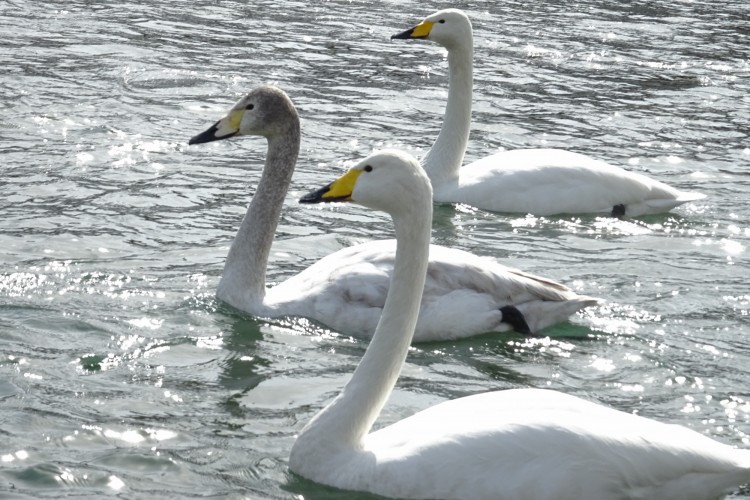



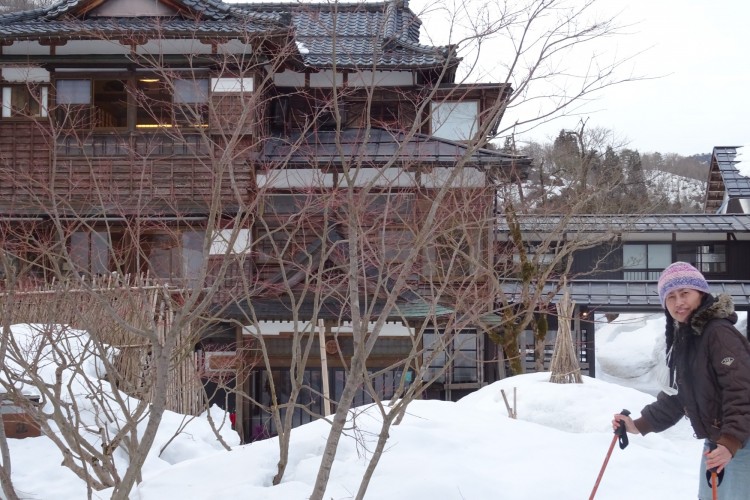

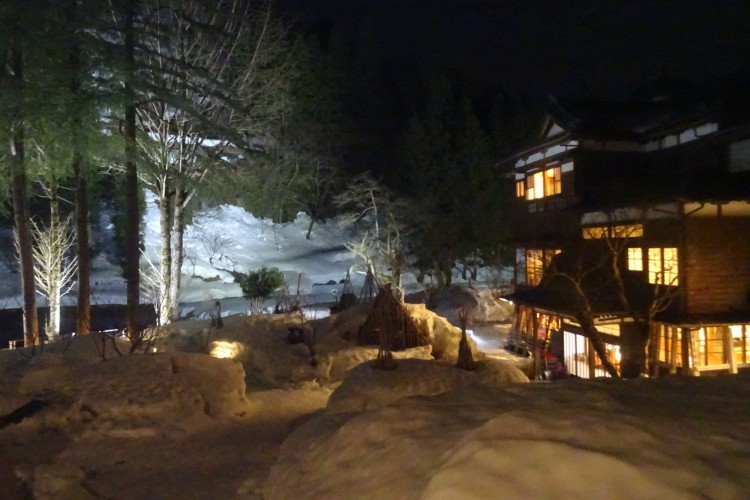


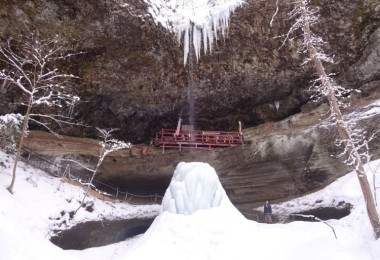
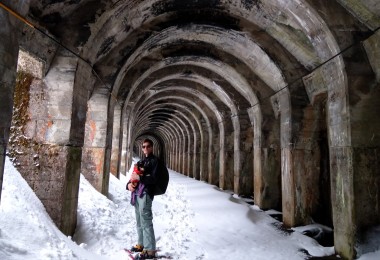

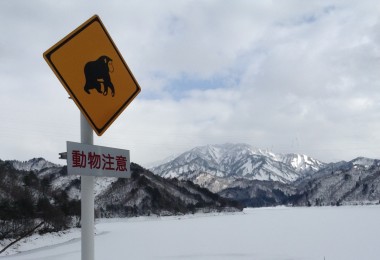

Awesome, Greg! You bring the snow country alive.
Thank you, Mr. O’Dowd, for your kind comment.